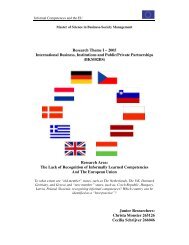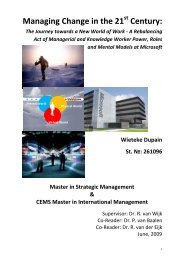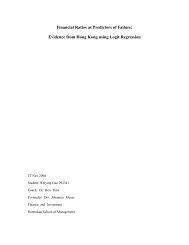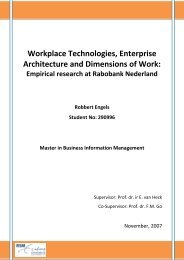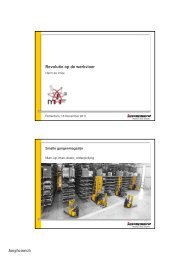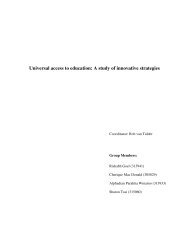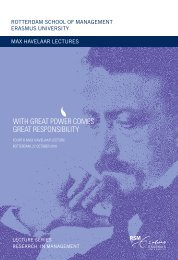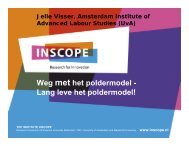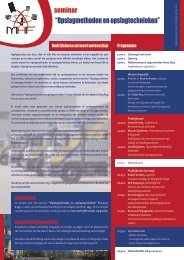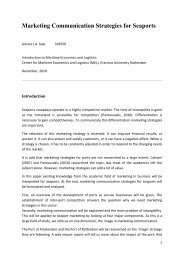You also want an ePaper? Increase the reach of your titles
YUMPU automatically turns print PDFs into web optimized ePapers that Google loves.
2 nd ONE-DAY CONFERENCE ON PROFESSIONAL ASSET MANAGEMENT<br />
<strong>Rotterdam</strong> <strong>School</strong> <strong>of</strong> <strong>Management</strong><br />
Erasmus University<br />
14 March, 2008<br />
Venue: Erasmus University <strong>Rotterdam</strong>, Burg. Oudlaan 50,<br />
3062 PA <strong>Rotterdam</strong>, The Netherlands<br />
M-building, room Tokyo (M1-17)<br />
Organizers: Joop Huij and Marno Verbeek<br />
www.erim.nl/mutualfunds<br />
www.erim.nl/hedgefunds<br />
Local arrangements: Carina Schlosser, email: cschlosser@rsm.nl<br />
In cooperation with CFA Netherlands, the Finance Group <strong>of</strong> RSM Erasmus University<br />
organizes a one-day academic conference on pr<strong>of</strong>essional asset management. The main<br />
objective <strong>of</strong> the conference is to present and discuss recent advances in academic research<br />
on mutual funds, hedge funds, pension funds, and other forms <strong>of</strong> delegated portfolio<br />
management. The conference will host a limited number <strong>of</strong> paper presentations with<br />
designated discussants and ample time for discussion and interaction.<br />
09.00-09.30 Registration<br />
Final program<br />
09.30-09.35 Welcome address by Marno Verbeek<br />
09.35-11.05 Session 1 Chair: Marno Verbeek<br />
“Reputation and Mutual Fund Choice”<br />
Laura Starks (McCombs <strong>School</strong> <strong>of</strong> Business)<br />
Discussant: Marno Verbeek (RSM Erasmus University)
“The Effects <strong>of</strong> Organizational Structure on Asset <strong>Management</strong>”<br />
Massimo Massa (INSEAD) and Lei Zhang (INSEAD)<br />
Discussant: Nicole Boyson (Northeastern University)<br />
11.05-11.25 Official signing ceremony<br />
<strong>Rotterdam</strong> <strong>School</strong> <strong>of</strong> <strong>Management</strong>, Erasmus University, becomes CFA program partner<br />
Dennis McLeavey (Head <strong>of</strong> Education, EMEA Region, CFA Institute)<br />
Eric Waarts (Dean BSc & MSc Programmes, RSM Erasmus University)<br />
11.25-11.45 Tea/C<strong>of</strong>fee<br />
11.45-13.15 Session 2 Chair: Gerard Moerman (AEGON Asset <strong>Management</strong>)<br />
“Is T<strong>here</strong> Hedge Fund Contagion?”<br />
Nicole Boyson (Northeastern University), Christ<strong>of</strong> Stahel (George Mason University),<br />
and Rene Stulz (Ohio State University)<br />
Discussant: Pieter-Jelle van der Sluis (GTAA Fund, ABP Investments)<br />
“Is a Team Different From the Sum <strong>of</strong> Its Parts? Evidence from Mutual Fund<br />
Managers”<br />
Michaela Bär (University <strong>of</strong> Cologne), Alexander Kempf (University <strong>of</strong> Cologne), and<br />
Stefan Ruenzi (University <strong>of</strong> Cologne).<br />
Discussant: Ronald van Dijk (ING Investment <strong>Management</strong>)<br />
“Missing the marks: dispersion in corporate bond valuations across<br />
mutual funds”<br />
Gjergji Cici (Mason <strong>School</strong> <strong>of</strong> Business), Scott Gibson (Mason <strong>School</strong> <strong>of</strong> Business), and<br />
John Merrick (Mason <strong>School</strong> <strong>of</strong> Business)<br />
Discussant: Patrick Herbst (Goethe University Frankfurt)
13.15-14.30 Lunch<br />
14.30-16.00 Session 3 Chair: Gerben de Zwart (ING Investment <strong>Management</strong>)<br />
“Style Investing and the ICAPM”<br />
Michael Stutzer (University <strong>of</strong> Colorado)<br />
Discussant: Hao Jiang (RSM Erasmus University)<br />
“The Impact <strong>of</strong> Work Group Diversity on Performance: Large Sample Evidence<br />
from the Mutual Fund Industry”<br />
Michaela Bär (University <strong>of</strong> Cologne), Alexandra Niessen (University <strong>of</strong> Cologne), and<br />
Stefan Ruenzi (University <strong>of</strong> Cologne)<br />
Discussant: David Blitz (Robeco Asset <strong>Management</strong>)<br />
“Spillover Effects <strong>of</strong> Marketing in Mutual Fund Families”<br />
Joop Huij (RSM Erasmus University) and Marno Verbeek (RSM Erasmus University)<br />
Discussant: Russ Wermers (University <strong>of</strong> Maryland)<br />
16.00-16.30 Tea/C<strong>of</strong>fee<br />
16.30-17.15 Session 4 Chair: TBA<br />
“False Discoveries in Mutual Fund Performance: Measuring Luck in Estimated<br />
Alphas”<br />
Russ Wermers (University <strong>of</strong> Maryland), Laurent Barras (Imperial College) and Olivier<br />
Scaillet (University <strong>of</strong> Geneva)<br />
Discussant: Jenke ter Horst (Tilburg University)<br />
This conference is made possible by financial support from Goldman Sachs, the Erasmus<br />
Research Institute <strong>of</strong> <strong>Management</strong> (ERIM) and the Vereniging Trustfonds Erasmus Universiteit<br />
<strong>Rotterdam</strong>.
Registration<br />
To register for this conference, please send an e-mail message to Carina Schlosser,<br />
cschlosser@rsm.nl, with your name and affiliation (as you wish to appear it on the<br />
conference badge). The registration fee is € 150 and includes lunch, c<strong>of</strong>fee/tea and copies<br />
<strong>of</strong> the papers. For CFA charter holders and VBA members a reduced fee <strong>of</strong> € 125 applies.<br />
Registration <strong>of</strong> participants from academic institutions is free. The deadline for<br />
registration is Friday 7 March 2008.<br />
The appropriate registration fee should be transferred to RSM Erasmus University,<br />
account number ABN/AMRO 42.90.14.155 (IBAN: NL67ABNA0429014155),<br />
mentioning “PAM conference 4070-743”. Please contact Carina Schlosser,<br />
cschlosser@rsm.nl, if you wish to receive an invoice.<br />
How to visit RSM Erasmus University<br />
By Air<br />
Arrival at Schiphol Airport Amsterdam: Direct train connection to <strong>Rotterdam</strong> Centre<br />
“Centraal Station” from the airport railway station, then take a taxi to the Erasmus<br />
University campus Woudestein (15 minutes).<br />
Arrival at <strong>Rotterdam</strong> Airport(European flights only): Taxi to Erasmus University<br />
<strong>Rotterdam</strong>, campus Woudestein.<br />
By Car<br />
Coming from the south (A16): First follow direction “Ring <strong>Rotterdam</strong>, Den Haag”. Near<br />
Ridderkerk, take directions “Feijenoord / Centrum / Kralingen / Capelle”. When crossing<br />
the Van Brienenoordbrug, take exit “<strong>Rotterdam</strong> Centrum / Capelle” and you will<br />
immediately arrive on a roundabout. On the roundabout take “<strong>Rotterdam</strong> Centrum”. Pass<br />
the Shell petrol station on your right side and take the first turn to the right after the Shell<br />
station. You have arrived at Burgemeester Oudlaan. Entrance <strong>of</strong> the Erasmus University<br />
main gate is 100 meters further on your right.<br />
Coming from Utrecht and Den Haag: Follow directions “Ring <strong>Rotterdam</strong> / Dordrecht”,<br />
and then “Kralingen / Feijenoord / IJsselmonde” and take exit “Capelle / Centrum”. At<br />
the traffic lights follow “<strong>Rotterdam</strong> Centrum”. Pass the Shell petrol station on your right<br />
side and take the first turn to the right after the Shell station. You have arrived at<br />
Burgemeester Oudlaan. Entrance <strong>of</strong> the Erasmus main gate is 100 meters further on your<br />
right.<br />
Parking is available on campus (parking fees will be charged).
By Public Transport<br />
From <strong>Rotterdam</strong> Central Station “Centraal Station”: Take the underground metro<br />
direction “Spijkenisse”, change at “Beurs/Churchillplein”. Take direction “Ommoord /<br />
Nesselande / Capelle”, exit at “Kralingse Zoom”. When exiting the station, facing the<br />
main road, the Erasmus University is directly across the road.<br />
You can also take tram number 7 or 21 to "Burgemeester Oudlaan", which leaves at the<br />
front <strong>of</strong> the central station approximately every 10 minutes. The trip will take around 20<br />
minutes and you should exit at the stop 'Erasmus Universiteit' in front <strong>of</strong> the main<br />
entrance.
ABSTRACTS<br />
“Reputation and Mutual Fund Choice”<br />
Laura Starks (McCombs <strong>School</strong> <strong>of</strong> Business) and Michael Yates ()<br />
We analyze individuals’ mutual fund holdings and trades to examine hypotheses<br />
regarding the effects <strong>of</strong> reputation on individuals’ mutual fund investment decisions. We<br />
present three key findings that suggest the importance <strong>of</strong> fund family reputation on<br />
mutual fund choice. First, even though our sample investors are purchasing funds through<br />
a discount brokerage firm, we find that individuals cluster their investments within<br />
particular families. Second, we show that sample investors are significantly more likely<br />
to purchase funds from families with which they have previous experience. Finally, we<br />
show that individuals’ beliefs about funds belonging to older and larger families change<br />
slowly, as evidenced by decreased flow-performance sensitivity for these funds.<br />
“The Effects <strong>of</strong> Organizational Structure on Asset <strong>Management</strong>”<br />
Massimo Massa (INSEAD) and Lei Zhang (INSEAD)<br />
We study how the strategies and performance <strong>of</strong> an asset management company are<br />
affected by its internal organizational structure. A more hierarchical and complex<br />
structure on the one hand reduces the incentives to collect “s<strong>of</strong>t” information and reduces<br />
performance. On the other hand, it limits managerial discretion and reduces moral hazard,<br />
curbing the incentive <strong>of</strong> the managers to engage in excessive risk taking. We focus on<br />
mutual funds and insurance companies. We have available information on the<br />
organizational structure <strong>of</strong> all the US mutual funds and insurance companies investing in<br />
US corporate bonds. We construct two measures <strong>of</strong> organizational structure: hierarchy<br />
and complexity. We show that more hierarchical structures invest less in firms located<br />
close to them and deliver lower performance. An additional layer in the hierarchical<br />
structure reduces the average performance by 19 basis points per month, while one<br />
additional competence reduces the average performance by 3 basis points per month.<br />
These effects are particularly strong in the case <strong>of</strong> insurance-run funds. At the same time,<br />
hierarchy and complexity lower the incentives to engage in end-<strong>of</strong>-the-year risk taking if<br />
lagging behind the peers. Moreover, more hierarchical and complex structure tend to herd<br />
more and to hold less concentrated portfolios. These findings are consistent with Stein’s<br />
(2002) theory <strong>of</strong> organization.
“Is T<strong>here</strong> Hedge Fund Contagion?”<br />
Nicole Boyson (Northeastern University), Christ<strong>of</strong> Stahel (George Mason University),<br />
and Rene Stulz (Ohio State University)<br />
We examine whether hedge funds are more likely to experience extremely poor returns<br />
when equity, fixed income, and currency markets or other hedge funds have extremely<br />
poor performance than would be predicted by correlations <strong>of</strong> hedge fund returns with<br />
returns on these markets or with returns <strong>of</strong> other hedge funds (contagion). First, we<br />
consider whether extreme movements in these markets are contagious to Arbitrage,<br />
Directional, and Event Driven hedge fund indices. Second, we investigate whether<br />
extreme adverse returns in one hedge fund index are contagious to other hedge fund<br />
indices. To conduct these examinations, we estimate Poisson regressions using both<br />
monthly and daily returns on hedge fund style indices. We find no systematic evidence <strong>of</strong><br />
contagion from equity, fixed income, and currency markets to hedge fund indices,<br />
although the Arbitrage index exhibits evidence <strong>of</strong> contagion from the equity and currency<br />
markets for monthly data. In contrast, we find systematic evidence <strong>of</strong> contagion across<br />
hedge fund styles for both monthly and daily data. Our results provide a new perspective<br />
on the systemic risks <strong>of</strong> hedge funds and suggest that diversification across hedge funds<br />
may not help as much as correlations would imply in reducing the probability <strong>of</strong> very<br />
poor returns.<br />
“Is a Team Different From the Sum <strong>of</strong> Its Parts? Evidence from Mutual Fund<br />
Managers”<br />
Michaela Bär (University <strong>of</strong> Cologne), Alexander Kempf (University <strong>of</strong> Cologne), and<br />
Stefan Ruenzi (University <strong>of</strong> Cologne).<br />
This paper provides the first empirical test <strong>of</strong> the diversification <strong>of</strong> opinion theory and the<br />
group shift theory using real business data. Our data set covers management teams and<br />
single managers <strong>of</strong> US equity mutual funds. All our results clearly reject the group shift<br />
theory and support the diversification <strong>of</strong> opinion theory: extreme opinions <strong>of</strong> single team<br />
managers average out and, consequently, teams take less extreme decisions than<br />
individuals do. We find that teams follow less extreme risk strategies and less extreme<br />
investment styles than single managers do. Consequently, single managers are much<br />
more likely to achieve extreme performance ranks.
“Missing the marks: dispersion in corporate bond valuations across<br />
mutual funds”<br />
Gjergji Cici (Mason <strong>School</strong> <strong>of</strong> Business), Scott Gibson (Mason <strong>School</strong> <strong>of</strong> Business), and<br />
John Merrick (Mason <strong>School</strong> <strong>of</strong> Business)<br />
We analyze important aspects <strong>of</strong> bond mutual fund pricing by examining the dispersion<br />
<strong>of</strong> month-end valuations placed on identical corporate bonds by different funds for net<br />
asset value (NAV) purposes. Our focus on the cross-fund dispersion <strong>of</strong> valuations on<br />
individual corporate bonds <strong>of</strong>fers insights on potential valuation problems at the<br />
individual security level as well as fund level. At the individual security level, we<br />
characterize how the dispersion across funds in the pricing <strong>of</strong> bonds for NAV purposes is<br />
affected by variables thought to be related to market liquidity – e.g., issue size and credit<br />
rating – as well as other bond-specific characteristic such as term to maturity. We also<br />
examine the statistical and economic significance <strong>of</strong> bond-pricing dispersion on<br />
crossfund NAV calculations and reported returns. Finally, we show that the trade<br />
reporting initiative instituted by the Financial Industry Regulatory Authority (FINRA)<br />
through the rollout <strong>of</strong> its Trade Reporting and Compliance Engine (TRACE) has directly<br />
benefited mutual fund investors by increasing the precision <strong>of</strong> mutual fund bond pricing.<br />
In the context <strong>of</strong> current controversies surrounding the marking <strong>of</strong> fixed-income security<br />
positions during the 2007 credit crisis, our findings <strong>of</strong> systematic differences in mutual<br />
fund marking behavior lead us to conclude that mutual fund NAV pricing practices may<br />
deserve further scrutiny and additional transparency.
“Style Investing and the ICAPM”<br />
Michael Stutzer (University <strong>of</strong> Colorado)<br />
Robert Merton's Intertemporal Capital Asset Pricing Model (ICAPM) predicts that assets'<br />
expected returns will be a linear function <strong>of</strong> the instantaneous expected excess returns (i.e.<br />
a "beta" relationship) <strong>of</strong> the market portfolio, as in the static CAPM, as well as a number<br />
<strong>of</strong> additional “hedge" portfolios. Each additional portfolio is the one most highly<br />
correlated with a time-varying (diffusion-generated) state variable that affects investors'<br />
indirect utilities (i.e. their Bellman value functions), derived from a sophisticated<br />
intertemporal consumption/investment choice problem posited by Merton. Merton<br />
defined the state variables to be a subset <strong>of</strong> the “parameters" <strong>of</strong> the assets' return<br />
processes (i.e. their instantaneous drifts and volatilities), thus causing intertemporal<br />
changes in the investment opportunity set. Hence those attempting to theoretically<br />
rationalize empirical multifactor regression models <strong>of</strong> asset returns have tried to establish<br />
that the factor portfolios optimally (for Merton's hypothesized consumption/investment<br />
problem) hedge Merton's hypothesized intertemporal changes in the investment<br />
opportunity set. But the same multifactor relationship will arise no matter how the state<br />
variables are defined – they need only enter the Bellman value function <strong>of</strong> enough asset<br />
demanders. Considerable asset demand arises from style investors, i.e. either index or<br />
exchange-traded funds that try to match the returns <strong>of</strong> style-specific benchmark portfolios,<br />
or active, pr<strong>of</strong>essionally managed funds (e.g. mutual, pension, endowment, private<br />
client, etc.) that are run with the objective <strong>of</strong> outperforming specific benchmark portfolios.<br />
A style investor's benchmark is a state variable in its value function, so it is (trivially)<br />
perfectly correlated with that state variable. Thus the aforementioned hedge portfolio<br />
result implies that the most popular benchmark portfolios should appear in the ICAPM<br />
relationship. It is argued that this interpretation <strong>of</strong> the ICAPM is more consistent with<br />
both statistical and direct behavioral evidence than the traditional interpretation. But then<br />
t<strong>here</strong> is no reason to believe that a positive intercept (“alpha") in a multifactor regression<br />
model indicates superior risk-adjusted fund performance for non-benchmark (e.g.<br />
conventional expected utility <strong>of</strong> wealth) investors, casting doubt on the many normative<br />
performance analyses predicated on the traditional interpretation.
“The Impact <strong>of</strong> Work Group Diversity on Performance: Large Sample Evidence<br />
from the Mutual Fund Industry”<br />
Michaela Bär (University <strong>of</strong> Cologne), Alexandra Niessen (University <strong>of</strong> Cologne), and<br />
Stefan Ruenzi (University <strong>of</strong> Cologne)<br />
This paper investigates the impact <strong>of</strong> work group diversity on performance. Analyzing a<br />
uniquely large sample <strong>of</strong> management teams from the U.S. mutual fund industry we find<br />
that the influence <strong>of</strong> diversity on performance depends on the dimension <strong>of</strong> diversity that<br />
is analyzed. Informational diversity has a positive impact on performance, which is<br />
driven by tenure diversity as well as educational diversity. Social category diversity has a<br />
negative impact on performance, which is mainly driven by gender diversity while age<br />
diversity has no strong impact. Our results have important implications for the optimal<br />
composition <strong>of</strong> work groups and for investment strategies <strong>of</strong> fund investors.<br />
“Spillover Effects <strong>of</strong> Marketing in Mutual Fund Families”<br />
Joop Huij (RSM Erasmus University) and Marno Verbeek (RSM Erasmus University)<br />
This paper investigates the presence <strong>of</strong> spillover effects <strong>of</strong> marketing in mutual fund<br />
families. We find that funds with high marketing expenses generate spillovers, and<br />
enhance cash inflows to family members with low marketing expenses. In particular,<br />
low-marketing funds that are operated by a family with high marketing expenses have<br />
substantially larger inflows after positive returns than otherwise similar funds that are<br />
operated by a family with low marketing expenses, while they have smaller outflows<br />
after negative returns. One way to interpret the spillovers is that they are a by-product <strong>of</strong><br />
individual fund marketing w<strong>here</strong>by the entire family is made more visible to investors.<br />
An alternative explanation <strong>of</strong> this observation is that funds with low marketing expenses<br />
are directly subsidized by family members with high marketing expenses. We develop<br />
and perform a set <strong>of</strong> tests to evaluate these two alternative hypotheses. The results <strong>of</strong> all<br />
tests support the subsidization hypothesis, and suggest that at least part <strong>of</strong> the spillovers<br />
can be attributed to favoritism. These results suggest that conflicts <strong>of</strong> interest between<br />
investors and fund families have been exacerbated by competition in the mutual fund<br />
industry.
“False Discoveries in Mutual Fund Performance: Measuring Luck in Estimated<br />
Alphas”<br />
Russel Wermers (University <strong>of</strong> Maryland), Laurent Barras (Imperial College) and<br />
Olivier Scaillet (University <strong>of</strong> Geneva)<br />
Prior approaches to identifying skilled funds in a population examine the performance<br />
<strong>of</strong> each fund in isolation, without regard to the role <strong>of</strong> luck in this multiple fund setting.<br />
Our paper develops a new, simple technique to properly account for "false discoveries",<br />
or funds which exhibit significant alphas by luck alone. As such, our approach correctly<br />
identifies the proportion <strong>of</strong> funds with truly positive or negative performance in any<br />
segment <strong>of</strong> the cross-sectional alpha distribution, even with cross-fund dependencies in<br />
estimated alphas. We find that 19.7% <strong>of</strong> U.S. domestic-equity funds exhibit truly<br />
negative four-factor alphas, while only 1.9% exhibit truly positive alphas. While the<br />
unskilled funds reside throughout the left tail, skilled ones are located only in the extreme<br />
right tail. Skilled managers are more common among aggressive growth funds and funds<br />
with lower turnover and expenses. Finally, by precisely locating truly skilled funds in the<br />
cross-sectional alpha distribution, our approach substantially improves the identification<br />
<strong>of</strong> funds with persistent performance.
Campus map





